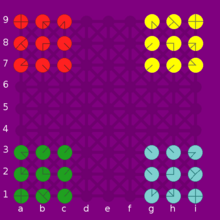Ploy
Ploy (or Imperium ) is the name of a board game for two or four parties. Additional possible rotations of the game pieces result in more possible constellations and moves than in chess .
history
Ploy was developed by Frank Thibault (selection list for game of the year 1989 with regatta ). Under this name the game appeared in 1970 at 3M in the ' Bookshelf Games ' series. In 1982 it was published by Schmidt Spiele under the name Imperium - "Sid Saxon" was incorrectly named as the author.
Rules of the game
game schedule
The game is played on a nine by nine square board, ideally with horizontal, vertical and diagonal connections drawn between the individual fields.
Game pieces
Ploy has four categories of tokens: Commander, Cruiser, Glider, and Probe. Each piece is circular and has one or more noses that indicate the possible directions of pull or impact with the respective piece (from one to four of eight possible).
The following table shows the different types of pieces:
| category | Commander | cruiser | Glider | probe |
|---|---|---|---|---|
| Appearance |
|
|
|
|
| Nasal number | 4th | 3 | 2 | 1 |
| maximum draw distance |
1 | 3 | 2 | 1 |
All of a player's stones have the same color (in the original game red, green, yellow and blue).
Trains
When it is a player's turn, he may either with one of his stones
- a movement train or
- a directional move
do.
In one move , a stone is pulled from its current position to another in the direction of one of its noses. The target position may be as far away as the maximum distance of the stone indicates. A stone may not move on or over stones of its own party, but it can move onto opposing stones and use them to capture them.
In one direction move , a stone is rotated on the square by integer multiples of 45 ° (the German game instructions only allow rotations of ± 45 °).
A probe may immediately connect a directional move after a movement move.
Elimination of a player
A player is eliminated if he has lost his commander or all of his stones except the commander.
Game variants
Ploy can be played by two or four players in one of the following variants:
- Game of two,
- Team game or
- Foursome.
In a two-player game , each of the two players receives 15 stones (see Figure 1). Green begins and the players take turns moving.
In a four-player game , each of the four players receives 9 stones (see Figure 2). Green starts and the players move clockwise. If the commander of a player is defeated in a game of four, he is eliminated and the batting player takes over his stones. He can then use them in his moves like his own stones.
In a team game , each of the four players receives 9 stones (see Figure 3). Green and yellow as well as red and blue each form a team. Green begins followed by red, yellow and blue, etc. If a player is eliminated in a team game, his team partner takes over his stones. The team partner also takes over his partner's right to move and may use all of his team's stones in a move.
Playing
The game ends
- if a player is eliminated in a two-man game,
- if three players are eliminated in a four-player game, and
- if both players of a team are eliminated in a team game.
Ploy programs
Two ploy programs are available: one that helps human players play, and another that allows the computer to make moves itself.
| program | Author (country) | Target platform | Computer pulls |
source | Programming language |
|---|---|---|---|---|---|
| JavaPloy v0.2 | Jeff D. Conrad (USA) | overall ( JVM ) | No | Open source, MIT license |
Java |
| Ada-Ploy v0.8 | Thomas Tensi (Germany) |
Microsoft Windows XP / Vista / 7 |
Yes | Open source, MIT license |
Ada 2005 |


